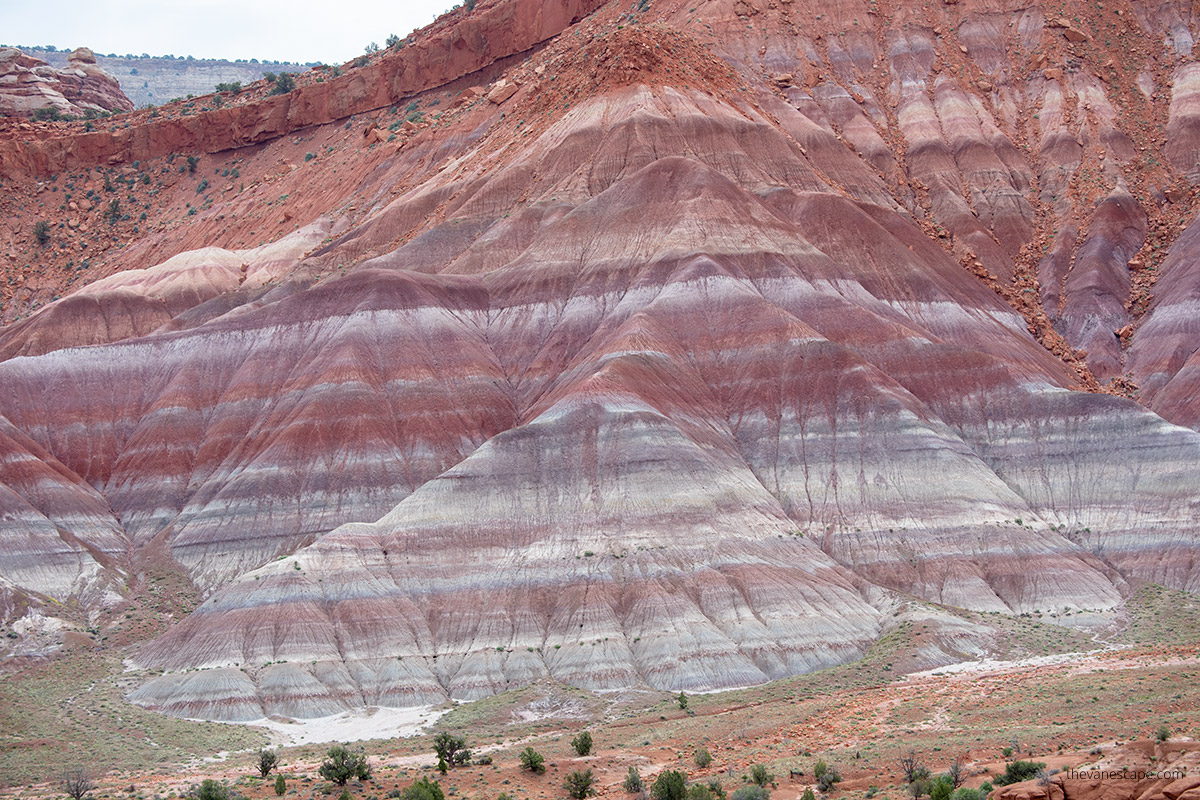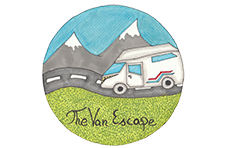Exploring Paria Townsite in Paria Rainbow Mountains
Among the many treasures hidden in the rugged landscapes of southern Utah, the Paria Townsite and Paria Rainbow Mountains are worth a visit. Whether you’re drawn to the colorful geology or the cinematic history, this region offers rich experiences. This guide takes you through our personal experiences exploring Paria, Utah. We’ll share insights, tips, and favorite spots to help you plan an unforgettable adventure.
This article may contain affiliate / compensated links. For full information, please see our disclaimer here.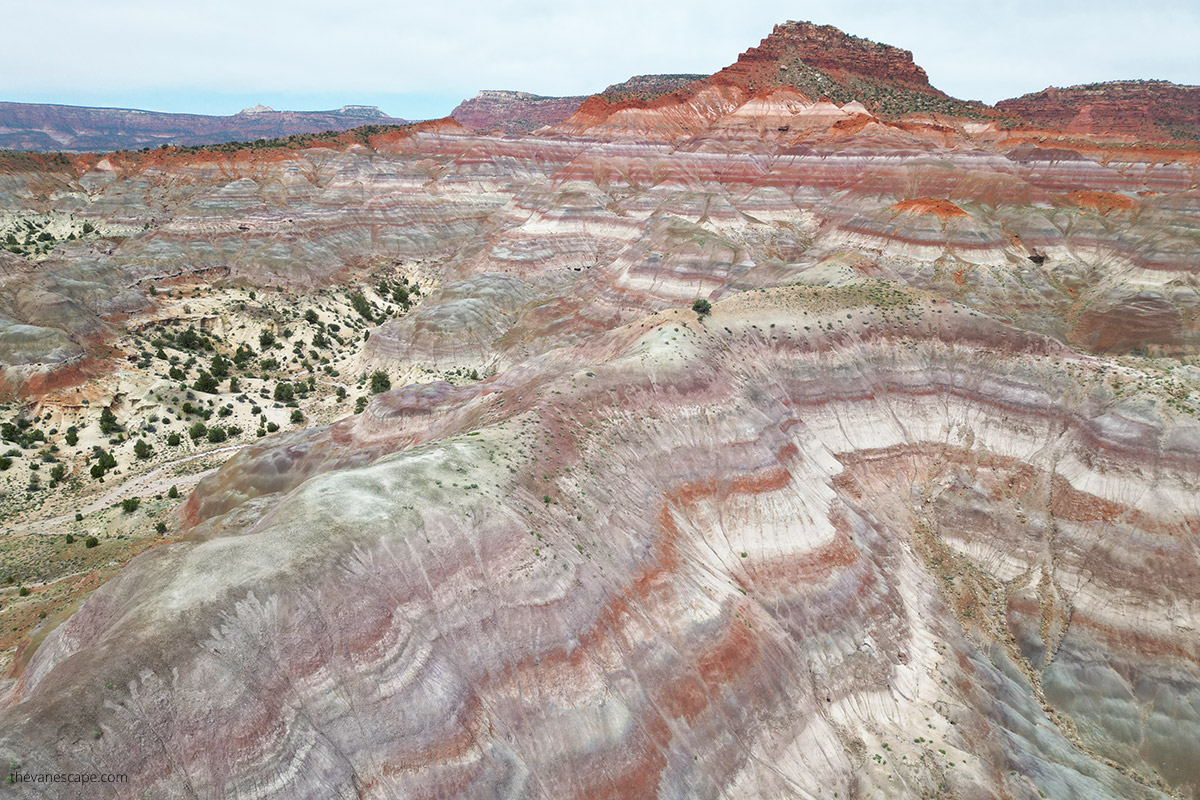
Paria Townsite and Paria Rainbow Mountains – Our Experiences
Southern Utah frequently draws us in with its picturesque scenery, some of the most stunning in the Southwest, and it’s no surprise that it has often served as the backdrop for Western movies. Among our favorite spots is the Kanab area, and the Paria Townsite holds a special place. Nestled in the Paria Rainbow Mountains, this unique location has captured the imagination of many film directors.
Every time we visit Utah, we make a point to explore this easily accessible site, just off the main Highway 89, as it never fails to delight us. We’re here to guide you on how to visit this remarkable place, delve into its rich history, and make the most of your time exploring it.
We’ll also provide directions on how to get there and share insights about other outstanding natural attractions in the area that you won’t want to miss.
Chris and I love this scenery rainbow scenery, so we took many photos, which we present in this article.
What is Paria Townsite?
Paria Townsite, also known as Old Paria or Pahreah, is a historical site near the Paria River in Utah. It’s situated within the stunning landscape of the Paria Rainbow Mountains, known for its colorful rock formations. Exploring this place is one of the best things to do in the Kanab, the closest city.
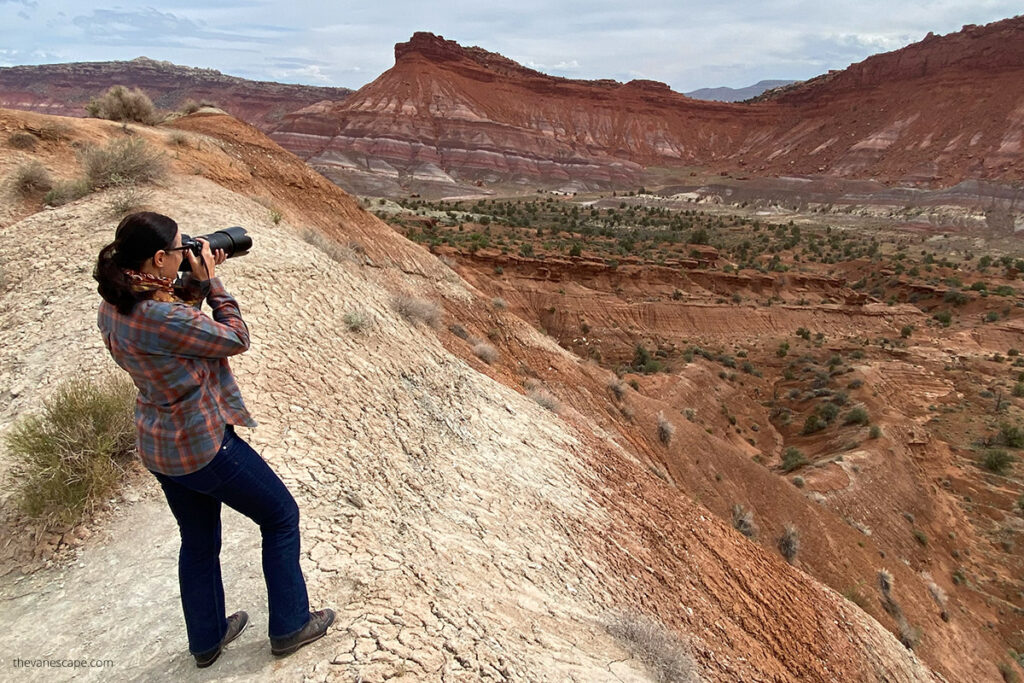
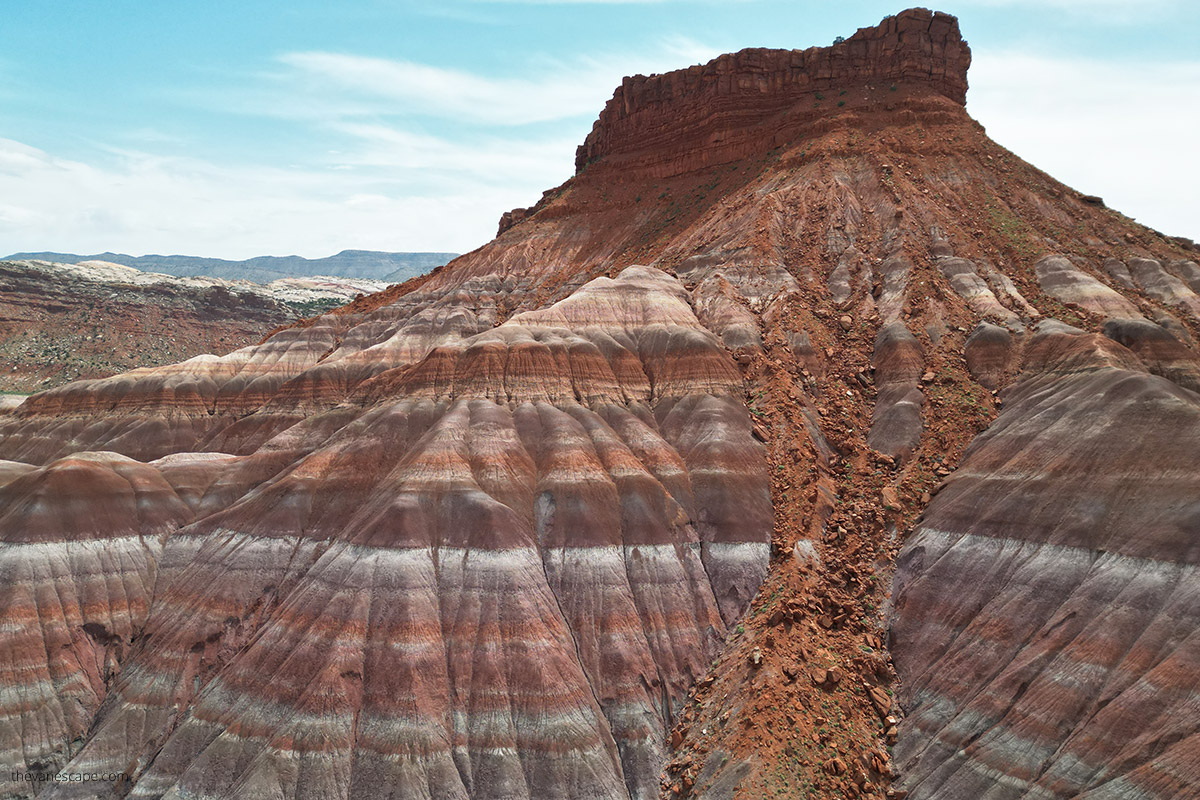
Historical Background
Early Settlement
In the early 1870s, settlers established Paria, Utah, also known as Old Paria or Pahreah. They were attracted to the area by the Paria River, which they saw as a vital water source for farming.
Challenges and Abandonment
However, the town soon faced significant challenges. The Paria River, initially an asset, frequently flooded, damaging farmlands and buildings. These floods forced the settlers to relocate the town in 1873, but the problems continued.
By the early 20th century, the population dwindled, and eventually, the community abandoned the town. Today, visitors can still see stone foundations and parts of collapsed structures.
Movie Set
The picturesque landscape around Paria, Utah, caught the attention of Hollywood filmmakers. The area’s unique geological features and the remnants of the old town provided an ideal backdrop for Western films, as the area of Kanab is known as “Little Hollywood.”
Notable Productions
Films such as “Sergeants 3” (1962), “Buffalo Bill” (1944), and “The Outlaw Josey Wales” (1976) were shot in the area. This cinematic history contributed to Paria’s fame and attracted tourists and film enthusiasts alike.
Our Tip: Read more about Western movie history in our article Kanab Utah’s Little Hollywood
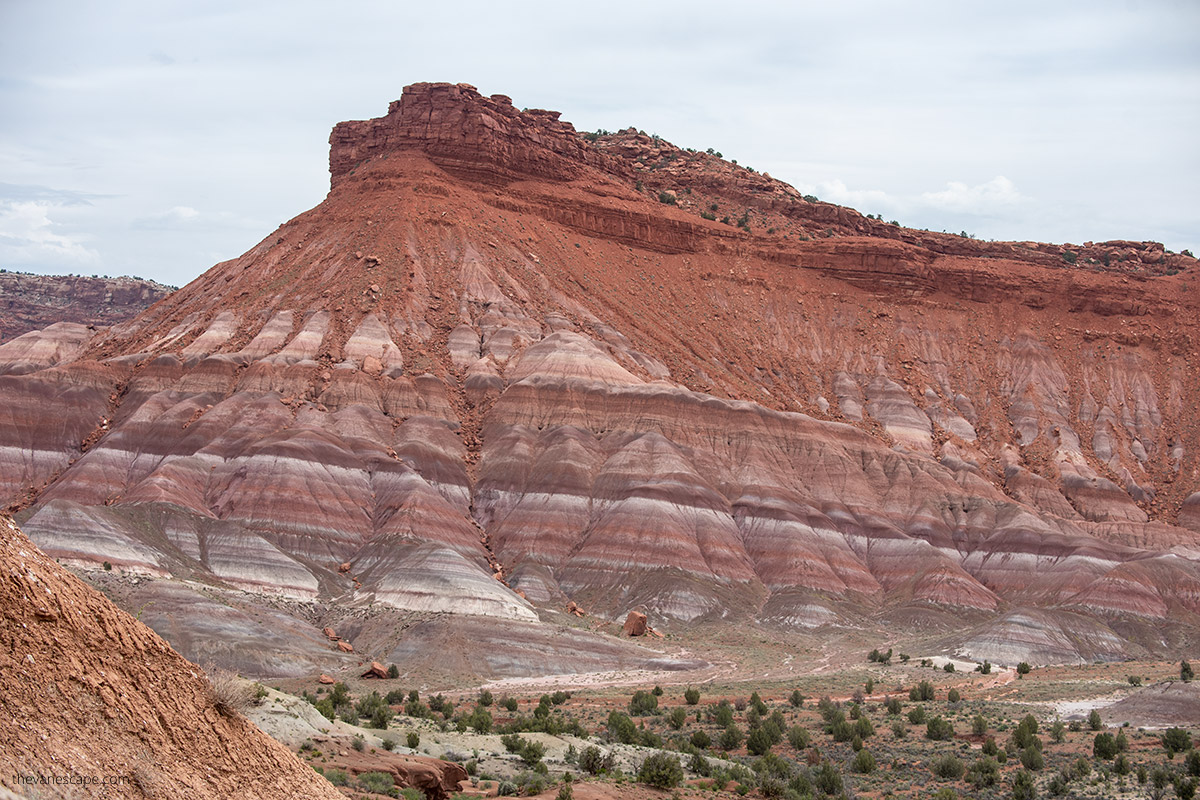
Movie Set Construction and Destruction
Crews constructed a replica of a Wild West town near the original Paria townsite to facilitate filming. This movie set became a popular tourist attraction, allowing visitors to step into the world of classic Western films. Tragically, a fire destroyed the movie set in 1999. Later, arsonists destroyed a replica in 2006, marking the end of Paria, Utah, as a filming location.
Exploration and Recreation
Visitors to Paria Townsite can explore the ghost town’s remnants, hike to the nearby cemetery, and enjoy the breathtaking scenery of the Paria Rainbow Mountains. The colorful rocks, layered cliffs, and wide valley of the Paria River provide ample opportunities for photography, hiking, and outdoor exploration.
Accessibility and Paria Movie Set Day Use Site
Paria Townsite is accessible via a 5-mile dirt road. There’s a picnic area for visitors to enjoy. It’s known as Paria Movie Set Day Use Site, and BLM manages it. It’s located east of Kanab on Highway 89, and the Old Town Paria rock marker marks the site.
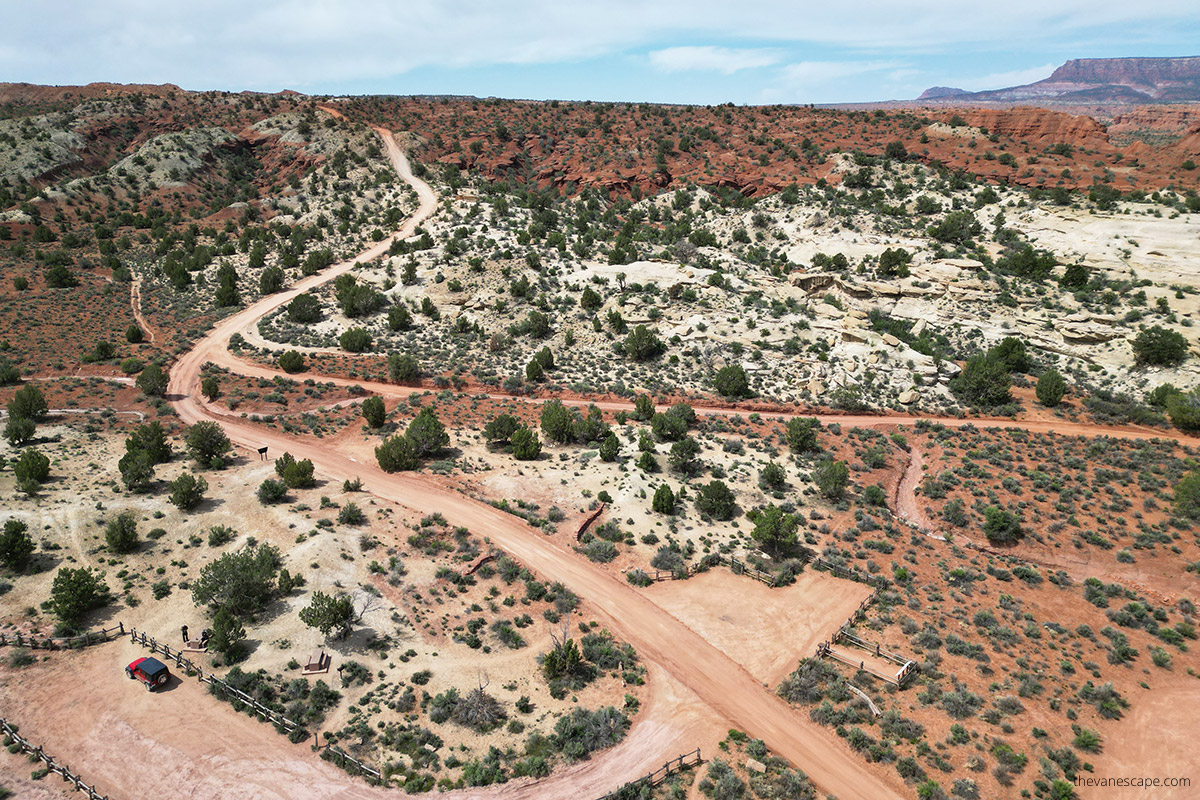
Driving Directions to Paria Townsite in Paria Rainbow Mountains
Here is access information from the nearest towns in this area, which are our favorite towns in Southern Utah.
From Kanab
- Distance: Approximately 33.5 miles east of Kanab.
- Route: Take Highway 89 east of Kanab.
- Landmark: Look for the Old Town Paria (Pahreah) rock marker at milepost 31. You will see it on the left side of Highway 89. There is also a parking area.
- Turn: Turn north at the marker and follow the 5-mile dirt road to the Paria Movie Set Day Use Site and picnic area. You will also see a sign at the beginning of the dirt road that you are in the Grand Staircase-Escalante National Monument area. It’s a gravel road, but if it’s dry, it’s passable in a regular car.

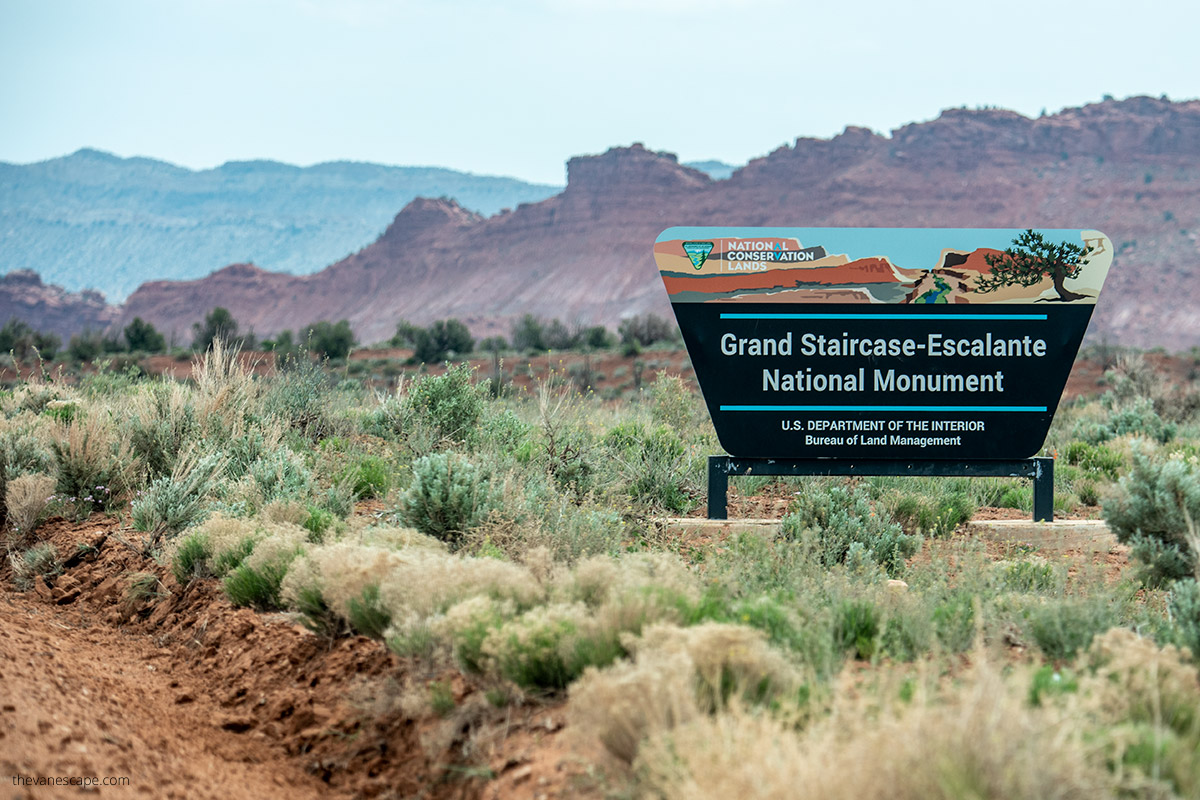
Driving From Page
- Distance: Approximately 40.5 miles west of Page.
- Route: Take Highway 89 west from Page.
- Landmark: Look for the sign that reads “Old Pahreah Townsite.”
- Turn right into the gravel parking area and follow the dirt road for 5 miles to reach the Paria Badlands.
From the town of Escalante via Cottonwood Canyon Road
- Distance: 98 miles and 3 hours of driving by a tough, gravel road.
- Route: Take scenic Cottonwood Canyon Road, a long cross-country route that leaves US 89 near milepost 18, close to the Paria River ranger station. [You might be interested in our related articles: The Best Things to do in Escalante and Lodging Options in Escalante].
- Landmark: Follow signs for the Paria River Valley, where Cottonwood Canyon Road meets the Paria River Valley.
- Turn: Continue on the road as it descends into the valley, leading to the remains of the Pahreah ghost town and the colorful rocks of the Paria River Valley.
https://maps.app.goo.gl/nHuPX1UzZX5Ynqjc6
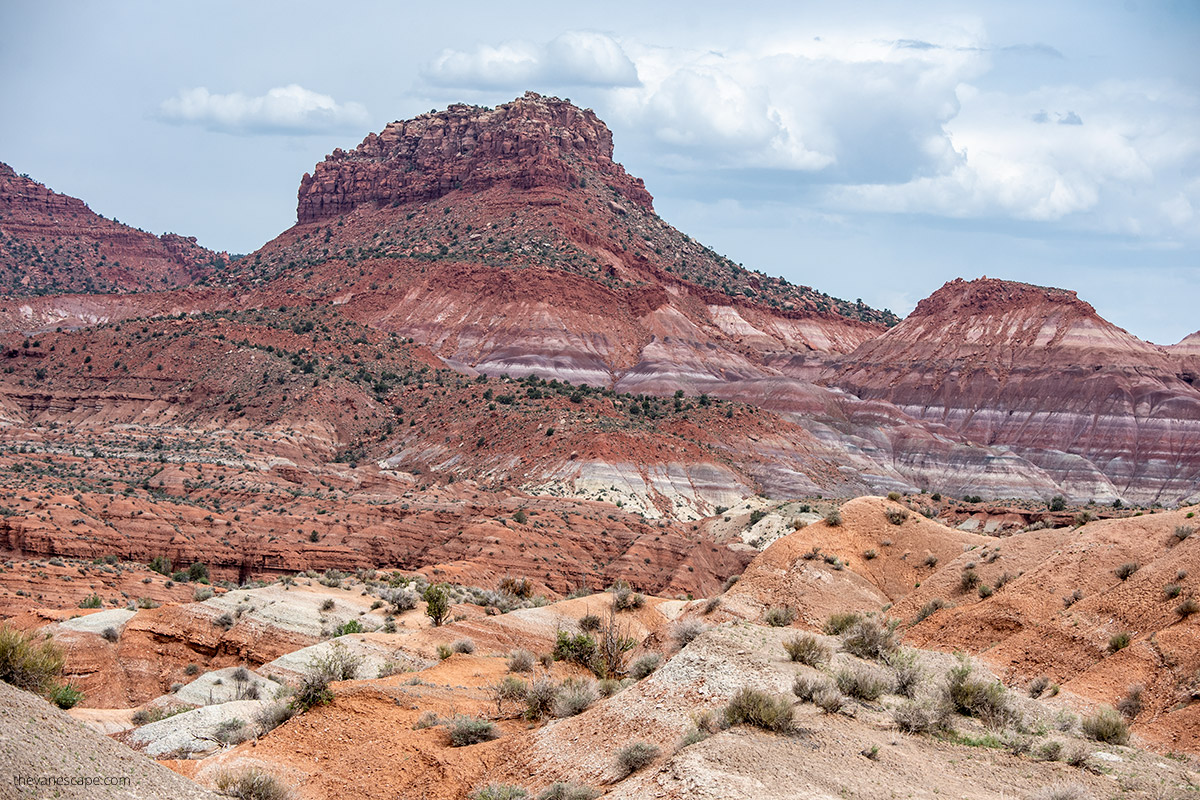
Paria Rainbow Mountains: A Geological Wonder
The Paria Rainbow Mountains are renowned for their strikingly colorful rock formations. Moreover, it is sometimes referred to as Paria Badlands. These mountains are a part of the Grand Staircase-Escalante National Monument and offer a visual feast for geologists, nature enthusiasts, and photographers alike.
Geological Formation
The vibrant colors of the Paria Rainbow Mountains are the result of millions of years of geological processes. Here’s a closer look at the factors contributing to their unique appearance:
- Sedimentary Layers: The mountains comprise various sedimentary rock layers, each representing different geological periods. These layers have been deposited over 85 million years, creating a rich tapestry of colors and textures.
- Mineral Encrustation: The vivid hues are attributed to the encrustation of iron oxides, manganese, cobalt, and others. These minerals have leached into the rock layers over time, staining them with shades of red, purple, yellow, and blue.
- Erosion: Wind and water erosion have sculpted the rocks into smooth, curved formations, revealing the multi-colored strata. The erosion process has also exposed the Petrified Forest Member of the Chinle Formation, adding to the area’s geological diversity.
- Tectonic Activity: The uplifting of the Colorado Plateau has further shaped the landscape, creating the dramatic cliffs and valleys that characterize the region.
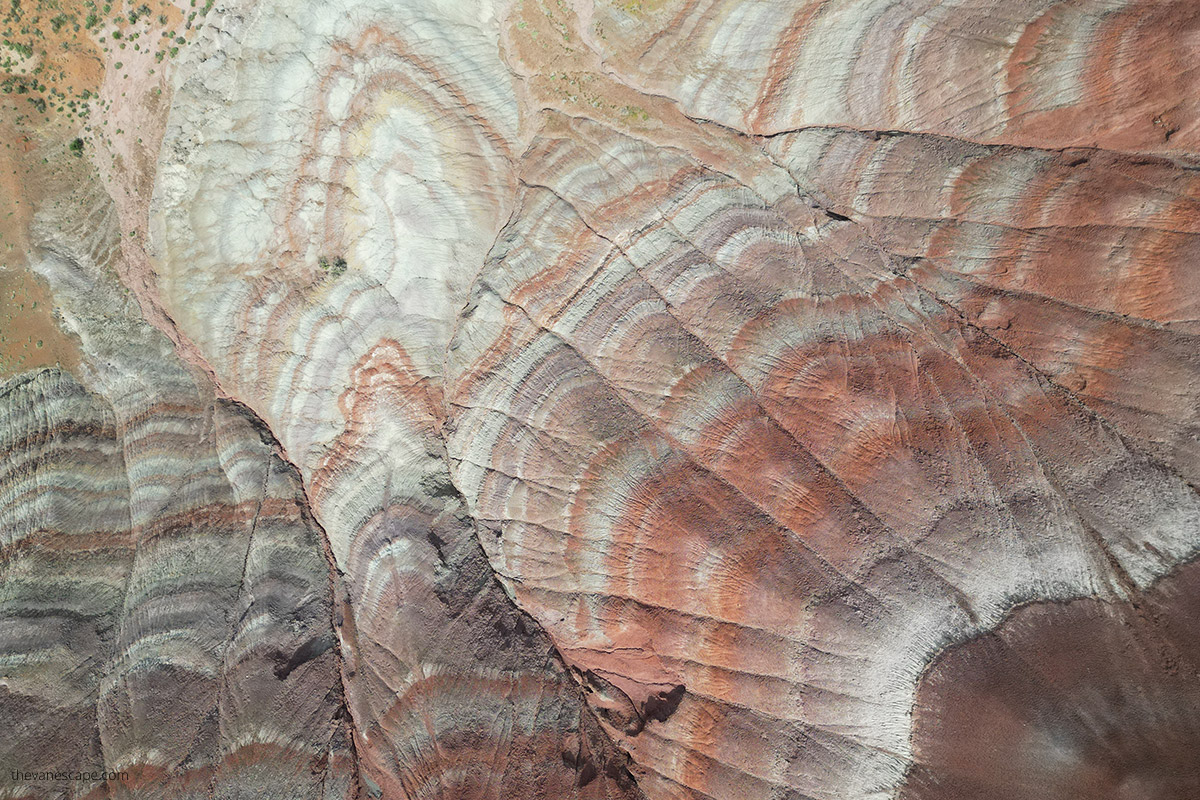
Specific Formations
- Chinle Formation: This geological formation is particularly prominent in the Paria Rainbow Mountains. It consists of alternating red, white, purple, and grayish-blue strata, contributing to the mountains’ rainbow-like appearance.
- White Cliffs: Part of the Grand Staircase, the White Cliffs are composed of Navajo Sandstone and distinctive features in the area.
- Paria River Valley: The broad valley of the Paria River runs through the region, often dry in summer but covered in white salt crystals from spring flash floods. The riverbanks provide a contrasting landscape to the colorful mountains.
Is Paria Rainbow Mountains the same as Bentonite Hills in Utah?
The Paria Rainbow Mountains and the Bentonite Hills in Utah are two distinct geological features with different formations, compositions, and locations. However, they share some similarities in appearance and formation.
Paria Rainbow Mountains
- Location: Situated in southern Utah, near the Paria River.
- Geology: Known for their colorful sedimentary rock layers, rich in minerals like iron oxides, manganese, and cobalt, which give them a rainbow-like appearance.
- Formation: Created over 85 million years through sedimentation, mineralization, erosion, and tectonic activity.
- Features: Includes the Chinle Formation, White Cliffs, and the Paria River Valley.
- Accessibility: Accessible via a 5-mile dirt road east of Kanab on Highway 89.
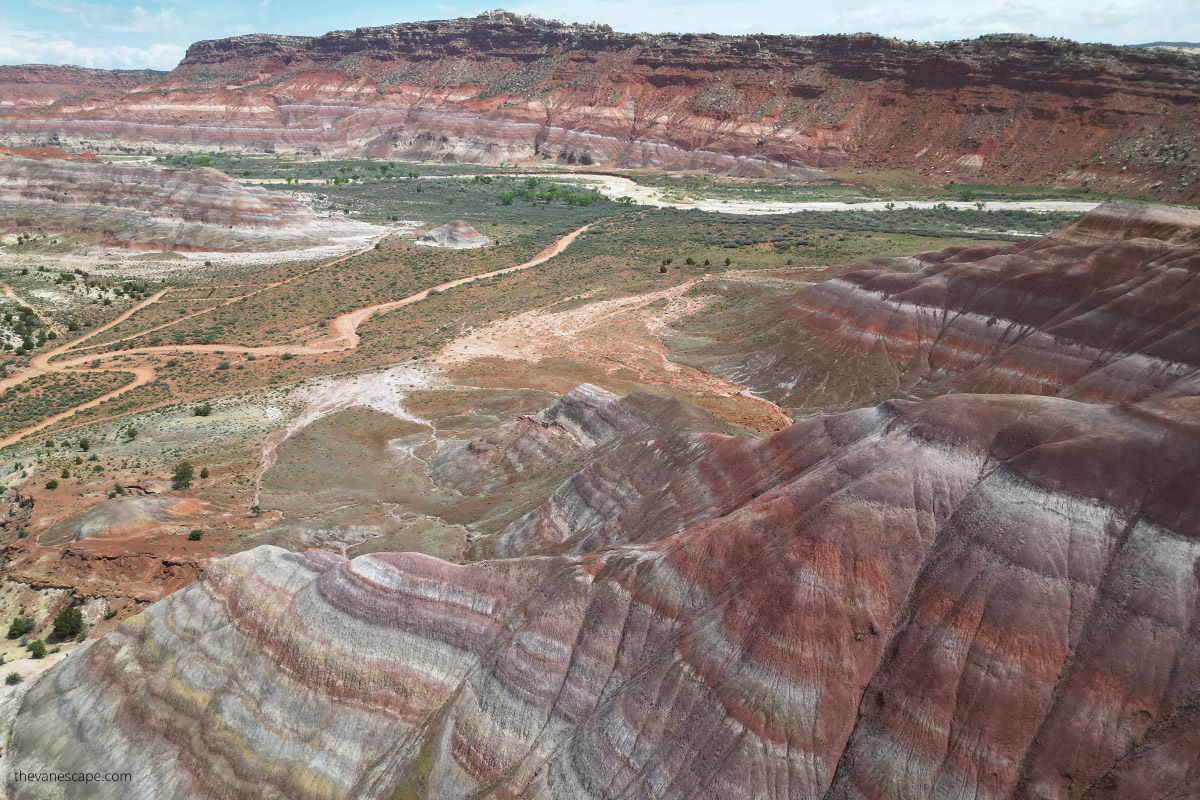
Bentonite Hills
- Location: Located in Capitol Reef National Park in south-central Utah.
- Geology: The Bentonite Hills, displaying blue-gray to red-orange hues, mainly consist of bentonite clay. This clay is a type of volcanic ash that has changed over time.
- Formation: Volcanic activity formed the Bentonite Hills, as ash settled in layers and later transformed into clay. The oxidation of iron in the clay gives it a unique coloration.
- Features: The Bentonite Hills feature rounded, eroded shapes and offer striking color contrasts, making them a notable geological landmark.
- Accessibility: Accessible via the Cathedral Valley Loop in Capitol Reef National Park.
Similarities and Differences
- Similarities: Both the Paria Rainbow Mountains and the Bentonite Hills exhibit colorful appearances, and geological processes like erosion and mineralization shape them.
- Differences: The primary difference between the two is their geological composition and formation. Various sedimentary rock layers form the Paria Rainbow Mountains, while volcanic ash is altered into clay composed of the Bentonite Hills.
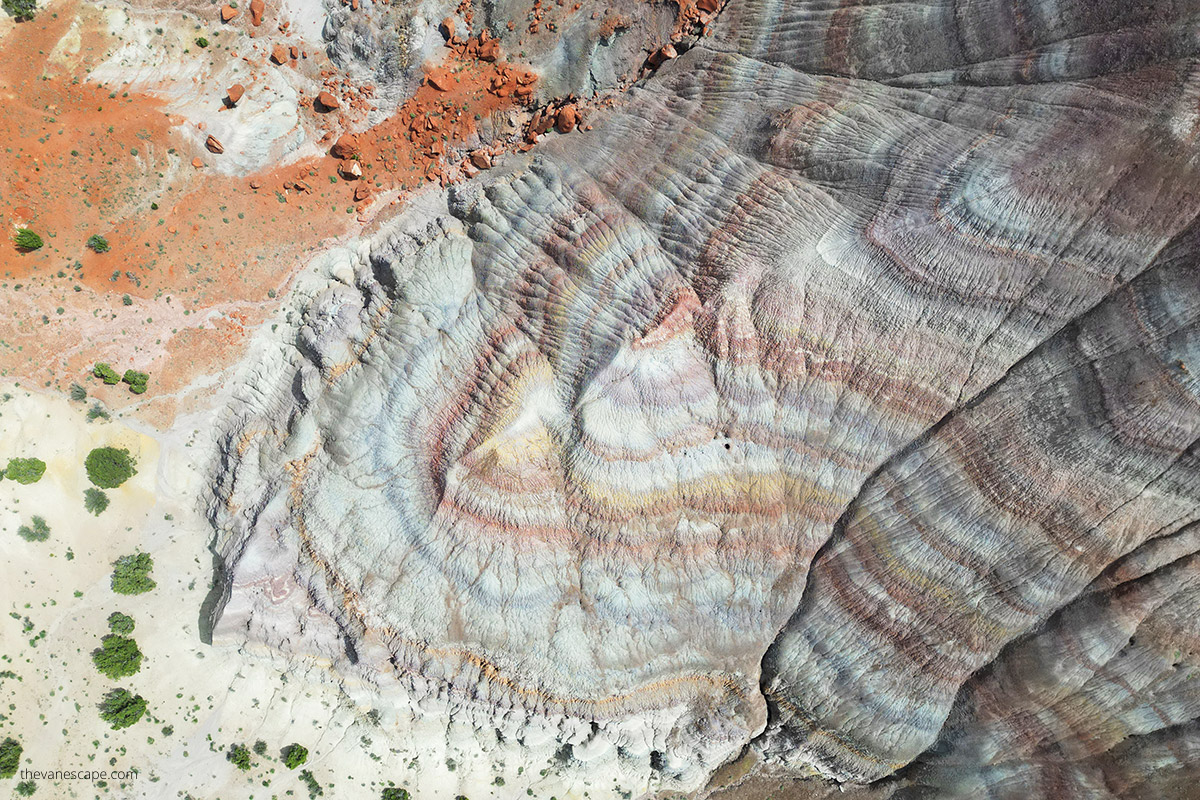
What to Do at the Paria Rainbow Mountains and Paria Townsite?
Enjoy the Scenic Drive
The drive to Paria Townsite, as with many roads in Utah, offers exceptional scenery. What sets this route apart is you don’t need a 4WD car to traverse the few gravel miles when it’s dry. Even if you travel by regular car, you can still enjoy the beautiful views along the way.
Take Pictures of the Paria Rainbow Mountains
- Capture the Colors: The vibrant hues of the mountains provide a perfect backdrop for photography enthusiasts. Whether on foot or through the lens of a drone, the opportunities for capturing breathtaking images are endless.
- Drone Photography: We took some stunning photos using a drone, as it’s allowed in this area. Before this road trip, we purchased Mini 3 Pro by DJI. The aerial perspective offers a unique view of the layered rock formations and colorful landscape.
- Sunrise and Sunset Shots: Visit during the golden hours for breathtaking sunrise and sunset photographs, either from the ground or above, with a drone (here is our review of the DJI Mini 3 Pro Drone, which is perfect for travelers).
Historical Exploration
- Paria Townsite: Explore the remnants of Paria Townsite, including stone foundations and parts of collapsed structures.
- Movie Set Location: Visit the site where many Western films were shot and see interpretive signs showing what the set used to look like.
- Visit The Old Paria Cemetery: Near the end of the road lies an old cemetery marked only by headstones without individual names.
Our Tip: Don’t anticipate finding the remnants of the so-called Paria Ghost Town that you might have read about on the internet; it no longer exists. Any traces of buildings or scenes from Western movies have been destroyed, either by fire or simply due to age. However, the scenery itself is genuinely cinematic, allowing you to immerse yourself in the atmosphere of the Wild West and feel a connection to a time long past.
Enjoy Camping and Picnicking
Pack some snacks and drinks for this trip. Use one of the picnic tables at the Paria Movie Set Day Use Site and enjoy your meal overlooking the Paria Rainbow Mountains. It is a fairy-tale scenery where you can calm down.
If you travel with a tent, you can pitch your camping in BLM lands and enjoy a night under the stars. But remember to follow all the rules related to it.
Go for a Hike
The Paria Rainbow Mountains are located in a remote and rugged area, and specifically named hiking trails might not be as well-established as in some other regions. There are no typical marked trails. Hiking there requires careful planning.
Moreover, it’s always a good idea to consult your hiking plans with local rangers for the most accurate and up-to-date information on trails, permits, and conditions. The closest Visitor Center in Kanab has a great staff who is happy to provide you with some tips. Always prioritize safety and adhere to Leave No Trace principles to preserve the area’s natural beauty.
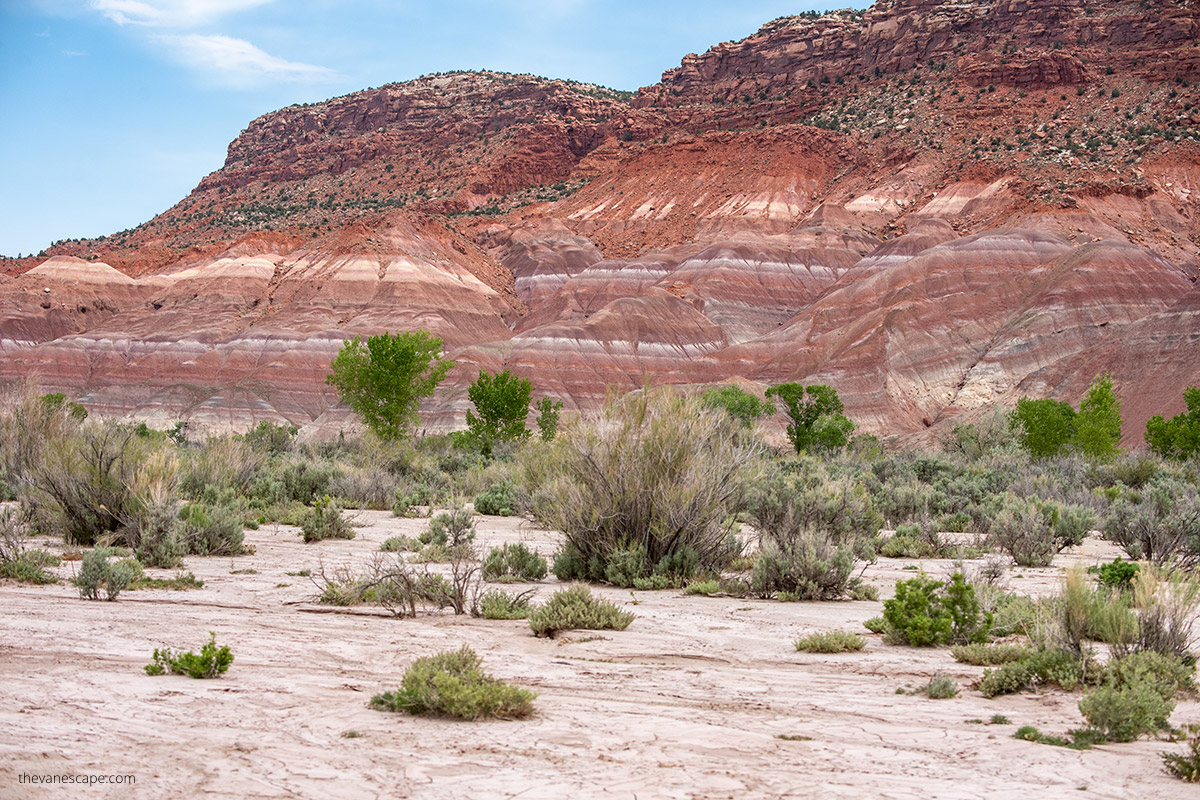
Other Attractions near Paria Townsite and Paria Rainbow Mountains
The Paria area is brimming with stunning locations, making it tricky to pinpoint the most exciting and beautiful ones. We’ve visited Kanab dozens of times, even living there for a few weeks as we attempted to win a permit to the Wave. And we’re already planning another road trip.
Below, you’ll find a list of our favorite places that you might want to consider adding to your itinerary. Whether you’re a first-time visitor or a returning explorer, these spots captivate your imagination and leave you longing for more.
Our favorite hikes and rock formations in the Paria, Utah area:
- Buckskin Gulch: Known as one of the longest slot canyons in the world, it offers a challenging and unforgettable hiking experience.
- Great Chamber: A stunning sandstone alcove in Cutler Point, often used for photography and film shoots.
- Peekaboo Canyon: Also known as Red Canyon, this slot canyon offers a scenic hike with beautiful red and orange sandstone walls.
- Paria Rimrock Toadstool Hoodoos: These unique rock formations resemble toadstools, with balanced boulders atop slender columns. A relatively easy hike leads to this fascinating geology display, offering excellent photo opportunities.
- The Nautilus Hike: Named to resemble the nautilus shell, this hike takes you to a swirling, layered sandstone formation. It’s a hidden gem that allows one to explore intricate patterns and colors in a more secluded setting.
- The Belly of the Dragon trail – is an easy and fun hike near Kanab.
- Willis Creek Slot Canyon – is an easy and stunning slot canyon in Southern Utah.
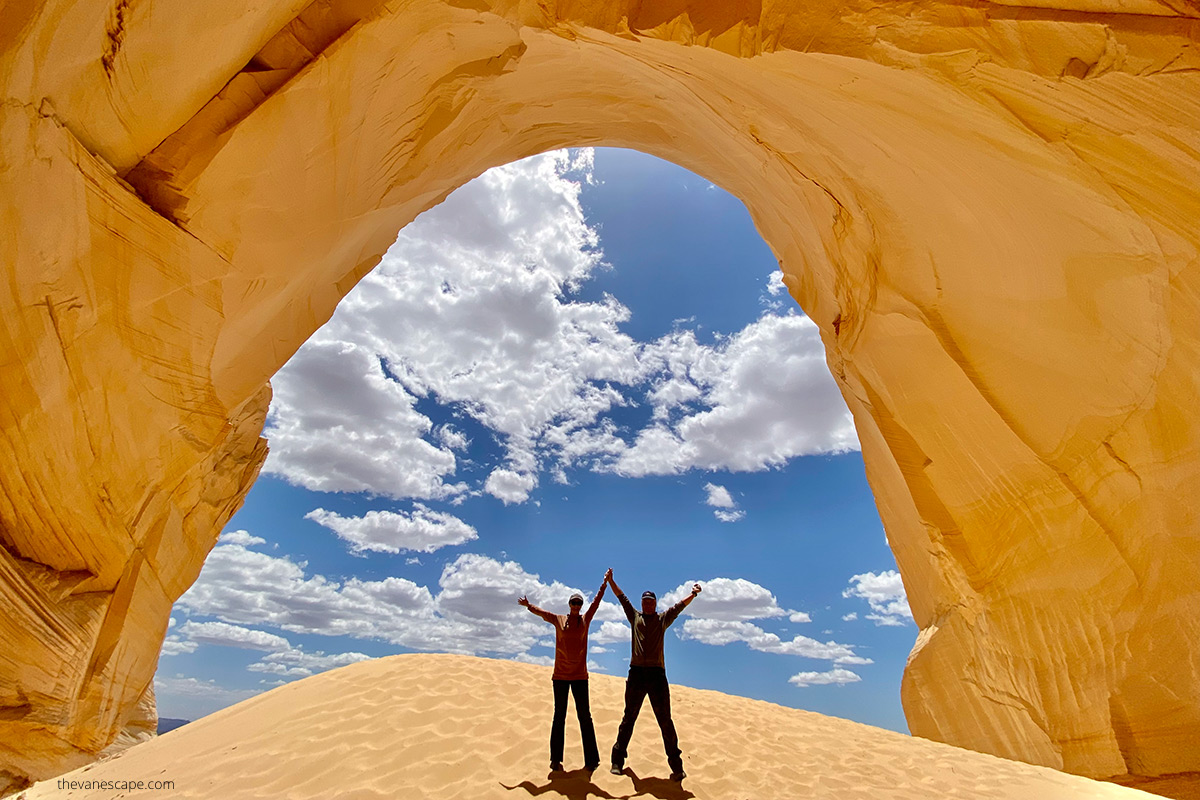
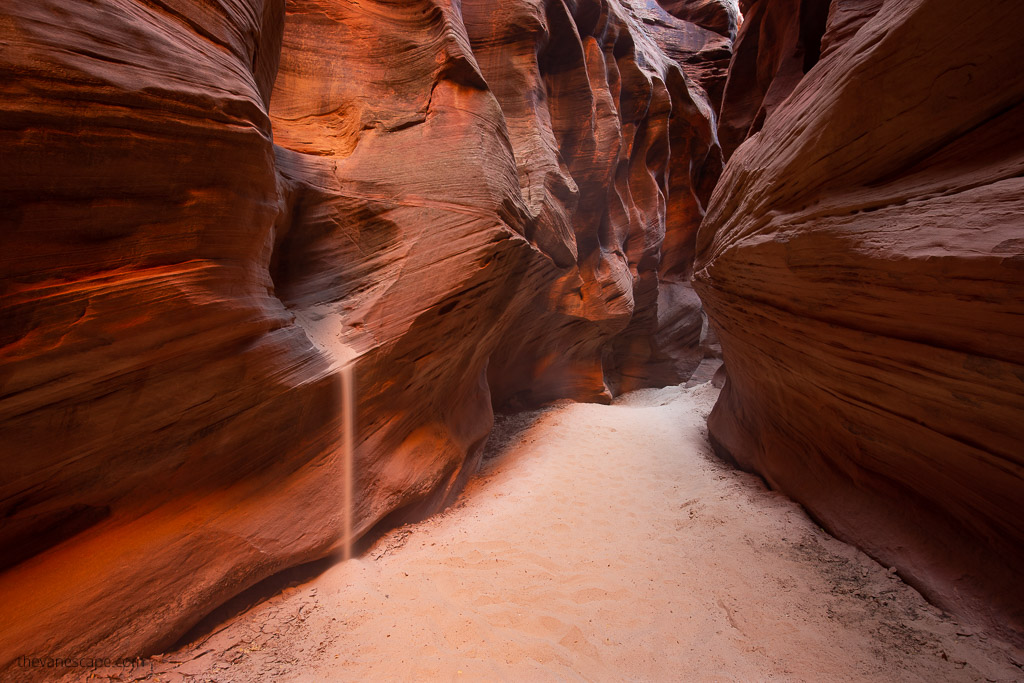
The most exciting national parks and state parks in the Paria area
- Coral Pink Sand Dunes State Park: Known for its unique pink-hued dunes and various recreational activities.
- Kodachrome Basin State Park: Named for its vibrant colors, unique sandstone chimneys, and various outdoor opportunities.
- Zion National Park: Famous for towering cliffs, narrow canyons, and diverse wildlife.
- Bryce Canyon National Park: Renowned for its unique hoodoo rock formations and outdoor activities.
- Capitol Reef National Park: Known for its geologic monocline, Waterpocket Fold, and various outdoor activities.
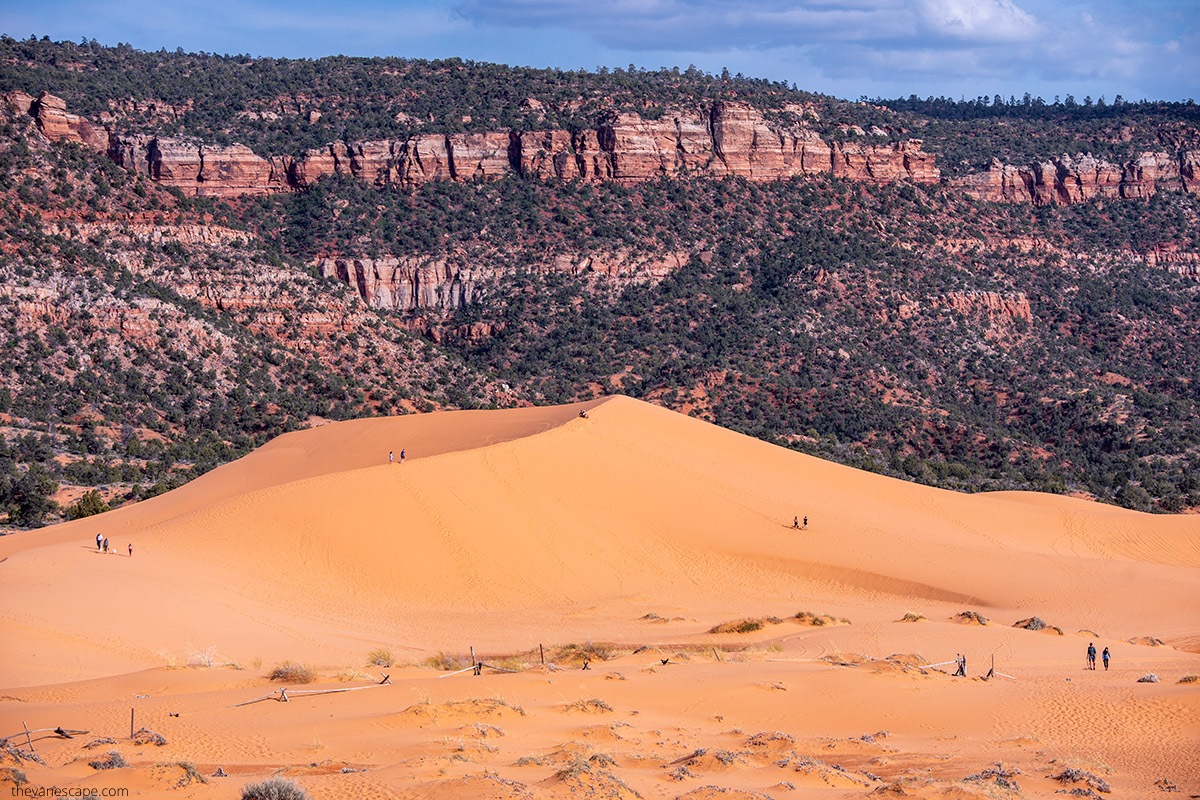
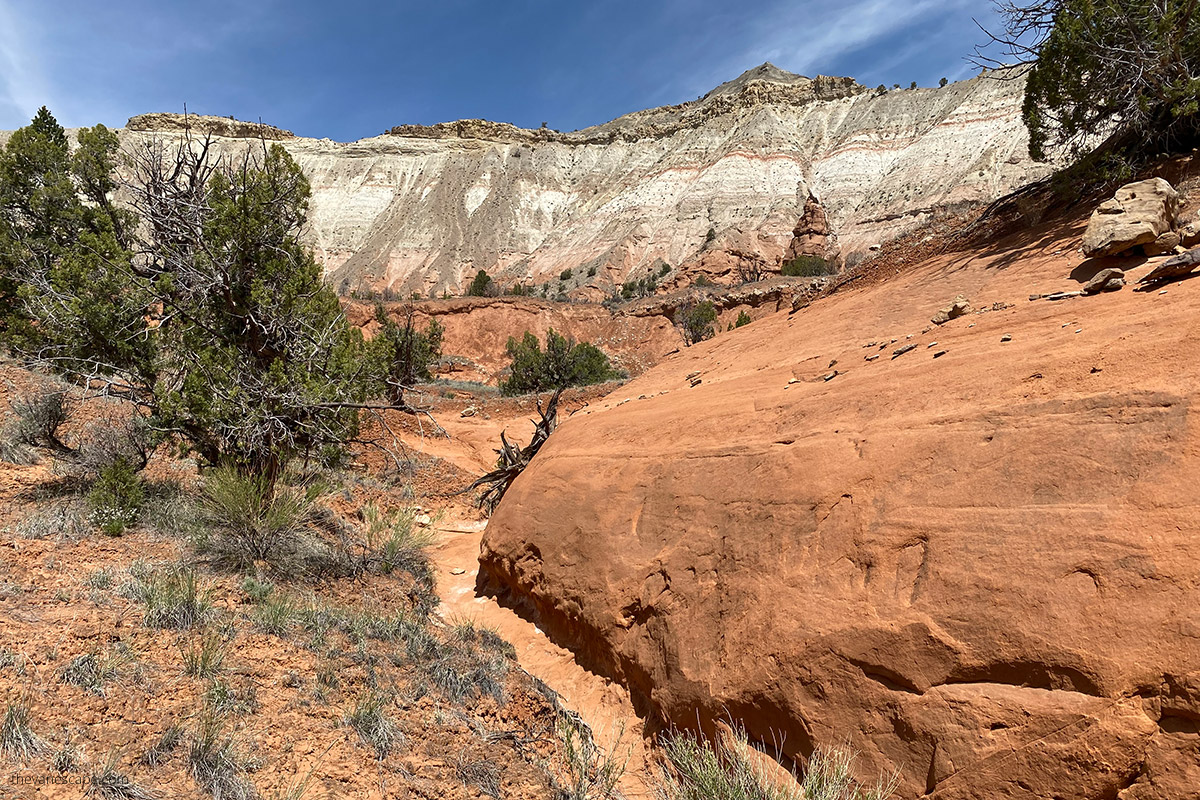
Paria Townsite and Paria Rainbow Mountains – Final Thoughts
Our explorations in the Paria area have left us with memories etched in vibrant hues, shaped by the stunning landscapes, rich history, and the ever-changing play of light and shadow on the rocks. Every visit to this part of Utah reveals something new, unexpected, and profoundly beautiful.
The Paria Townsite and Paria Rainbow Mountains are more than just a destination; they are a journey into a world where nature’s artistry and human history intertwine. Whether you’re hiking, capturing the colorful badlands, or simply soaking in the atmosphere of the Wild West, this region invites you to explore, discover, and connect with something truly extraordinary.
As we reflect on our numerous visits and look forward to our next road trip, we hope this guide inspires you to embark on your adventure in the Paria area. May you find joy in the journey, wonder in the wilderness, and a connection to a place that continues to captivate and delight us. Happy exploring!
